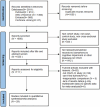Potential biomarkers for cerebral small vessel disease with cognitive impairment: a systematic review and meta-analysis
- PMID: 39839309
- PMCID: PMC11747022
- DOI: 10.3389/fnagi.2024.1475571
Potential biomarkers for cerebral small vessel disease with cognitive impairment: a systematic review and meta-analysis
Abstract
Cerebral small vessel disease (CSVD) is a common factor in age-related diseases such as stroke and dementia, and about half of dementia patients worldwide are caused by CSVD. CSVD-related cognitive impairment (CSVD-CI) affects more and more elderly people, resulting in economic losses and burdens on families and society. In recent years, circulating biomarkers have made breakthroughs and played an increasingly important role in the diagnosis, progression, and prognosis of CSVD-associated cognitive impairment, and are expected to be applied to the early clinical detection, diagnosis, and treatment of patients with cerebral small vessel disease. Through a systematic review and meta-analysis, this study aimed to assess the relationship between circulating factors and cognitive impairment associated with cerebral small vessel disease, especially the possibility of becoming the potential biomarkers for diagnosis. Articles published before November 2023 were searched in four databases, PubMed, Web of Science, Embase, and Cochrane Library, to identify all relevant studies reporting circulating markers in patients with CSVD. Twenty-nine articles out of 2,911 were finalized for this study. We meta-analyzed 2 or more articles that were jointly considered to be circulating biomarkers of CSVD-CI and summarized a total of 4 possible biomarkers: homocysteine (Hcy), high-sensitivity C-reactive protein (hs-CRP), lipoprotein-associated phospholipase A2 (Lp-PLA2), and neurofilament protein light chain (NfL). The results revealed that patients in the CSVD-related cognitive impairment group had significantly higher levels of Hcy and hs-CRP than those in the CSVD-without cognitive impairment group, whereas there was no statistically significant difference in Lp-PLA2 and NfL between the two groups. Therefore, Hcy, hs-CRP may be considered circulating markers of cognitive impairment associated with cerebral small vessel disease.
Keywords: blood biomarker; cerebral small vessel disease; cognitive impairment; dementia; meta-analysis.
Copyright © 2025 Liao, Huang, Ma, He, Su and Sha.
Conflict of interest statement
The authors declare that the research was conducted in the absence of any commercial or financial relationships that could be construed as a potential conflict of interest.
Figures


References
-
- Cao Y., Lyu X., Cheng Z., Tang Q. (2019). Correlation study of serum 3-NT levels in patients with cerebral small vascular disease and their relationship with cognitive impairment. Chin. J. Nervous Mental Diseases 45, 710–714. doi: 10.3969/j.issn.1002-0152.2019.12.002 - DOI
Publication types
LinkOut - more resources
Full Text Sources
Research Materials
Miscellaneous

